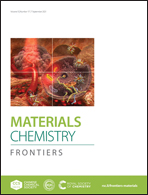Growth of robust metal–organic framework films by spontaneous oxidation of a metal substrate for NO2 sensing†
Abstract
As with most functional materials, integrating metal–organic frameworks (MOFs) in a miniaturised fashion can easily achieve portable multifunctional platforms. However, the construction of MOF films with remarkable robustness and adhesion between the MOF crystals and the substrate still remains challenging. Herein, a facile strategy involving the spontaneous oxidation of a metal substrate was proposed for the development of robust MOF films. By utilizing the metal substrate as the only metal source, five different MOF films can be synthesized in different ligand solutions. The high quality of the as-obtained MOF films is proved by adhesion examinations through scanning electron microscopy measurements. It should be noted that even in strong corrosive environments the as-prepared products can be well preserved, ensuring their applications in extreme environments. Among them, ZJU-66 with a newly reported structure was selected as a representative to demonstrate its outstanding NO2 sensing performance by hindering the excitation and emission processes due to the strong electron absorption capacity of NO2. We believe that this general strategy illustrated in this work can open up a new avenue for the development of other high-quality and highly stable MOF films with potential applications for various fields.



 Please wait while we load your content...
Please wait while we load your content...